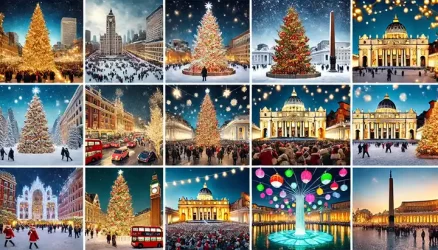Places to Visit in Malawi, Africa
Malawi, a small country in southeastern Africa bordering Tanzania and Mozambique, offers a variety of reasons to come. Despite its small, it is home to the world’s fourth-largest lake in terms of volume, as well as a diverse range of exotic wildlife. Visit these must-see locations to get a taste of the finest it has to offer.
Livingstonia
Livingstonia is a historic and cultural site near Nyika National Park that not only gives panoramic views of Chitimba Bay and the Livingstone Mountains in Tanzania beyond. With stunning old stone houses, lovely churches, and farms, the little town is tranquil and evocative. It also has Stone House, a remarkable museum that chronicles the introduction of Europeans in Malawi and the first missionaries. Manchewe Falls, located just outside of town, plunges nearly 400 feet into the valley below.

Liwonde National Park
Liwonde National Park, which runs along the Shire River and part of Lake Malombe, is one of the most popular areas to see animals. There are marsh bogs, grass fields, flood plains, and baobab trees in this enormous reserve. Walking and vehicle safaris are both offered, allowing visitors to get up close and personal with baboons, impalas, elephants, hippos, crocodiles, and even endangered black rhinos. The vegetation is equally amazing, with everything from tranquil lily ponds to massive, multicolored orchids.

Chintheche
There are numerous beaches around Lake Malawi’s coasts, but the length near Chintheche on the northern shore is widely regarded as the nicest. The lovely white sands and green surroundings may give you the impression that you’re in the Caribbean. Take a walk along the crystal-clear sea to see the rock formations, go swimming or snorkeling, or go on a boat ride. Horse stables are just a short drive south, where you may go on rides that last anywhere from a few hours to two weeks.

Nyika National Park
Nyika is Malawi’s largest national park, covering 1,235 square miles high on the Khondowe Plateau. Its grasslands are home to everything from leopards and zebra to spotted hyena, eland, and antelope, as well as 425 bird species, making it ideal for wildlife watching. Elephant and lion sightings are also possible.

Nkhata Bay
Nkhata Bay is a natural harbour and a major fishing port in the area. Observe the locals jumping into the sea and consider joining them for a swim. The major reason to visit is to view the results of the local artisans’ amazing ingenuity and entrepreneurial enthusiasm at the crafts market. Necklaces, masks, ornate bowls, nativity sets, and chief seats, one of Malawi’s distinctive products, are just a few examples.

Kasungu National Park
This park, situated in the rolling plateaus of western Malawi near the Zambian borderlands, was formerly noted for its large population of elephants, but poaching concerns have reduced their numbers from 1,000 to only 70 in recent decades. The good news is that ecotourism is assisting in their growth. A safari here will not only help them, but it will also give you the chance to see antelopes, kudus, impala, and hartebeest, plains zebra, and African buffaloes that reside in the bush, savannah, woodland, and dusty plains.

Majete Wildlife Reserve
The Shire and Mkulumadzi Rivers converge at Majete Wildlife Reserve, making it one of Malawi’s largest protected areas. During the drier months of June through November, a lot of game congregates near these water sources. Elephants, zebra, kudu, eland, baboon, black rhino, and monkey are just a few of the animals you might see. There are predators such as leopards and spotted hyenas lurking about, while bird watchers can sight over 250 species, including lappet-faced vultures.

Lake Malawi National Park
The park is situated among the beautiful mountains that surround Malawi’s largest lake, Lake Malawi. Keep an eye out for antelopes and baboons who stroll along the beach and investigate the ruins of former missionary settlements. With the biggest concentration of African fish eagles on the continent, the park attracts a large number of bird enthusiasts. Their cries echo across the sky frequently.

Chongoni Rock Art Area
The UNESCO-protected Chongoni Rock Art Area is located near Dedza in central Malawi. It consists of 27 sites scattered throughout the Malawi plateau’s wooded hills and granite outcrops. The work of farming communities from the Late Stone Age and the Iron Age, it is the richest concentration of such art in central Africa. The paintings are frequently associated with women’s initiation, rainmaking, and burial rites, all of which are Chewa customs. Chongoni Mountain, the region’s largest mountain, has the highest concentration of rock art, with multiple easily accessible rock panels.

Mount Mulanje, Mulanje
Mount Mulanje, just a few miles from the Mozambique border, is a must-see for every hiker or climber visiting Malawi. Sapitwa Peak, at over 9,900 feet, is the highest peak in south-central Africa, and the area around it is one of the most scenic in the country. Mulanje Cedar trees, some of which are over 200 years old, flourish on the steep slopes. There are marked hiking paths as well as camping shelters scattered across the mountain with basic camping equipment, cooking facilities, fireplaces, and mattresses, all of which are part of the Mulanje Forest Reserve. Water and firewood are also available at some of the huts, as well as cool refreshments. Mulanje, a small town in Malawi, is the epicenter of the country’s tea-growing business.




















